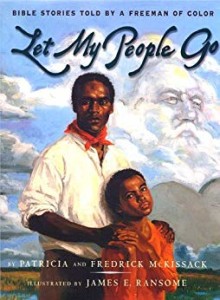Making Connections to Bible Stories
 As I was searching for material for Black History Month and Martin Luther King Jr. Day I came across Let My People Go by Patricia and Fredrick McKissack. I was intrigued by the unique blend of historical fiction and Old Testament Bible stories written in black storytelling dialect.
As I was searching for material for Black History Month and Martin Luther King Jr. Day I came across Let My People Go by Patricia and Fredrick McKissack. I was intrigued by the unique blend of historical fiction and Old Testament Bible stories written in black storytelling dialect.
In the authors’ notes, the McKissacks say,
Our hope is that this book will be a lighthouse that can guide young readers through good times and bad; that it will show others that the Bible is a wonderful tool to help meet the challenges of daily life. The ideas these ancient stories hold are not for one people, at one time, in one place. They are for all of us, for all times, everywhere.
After reading Let My People Go I see it as a great book for mid-grade students and a great mentor text for authors. The dialect draws the reader and listener into the stories. It makes the stories feel familiar, therefore more applicable. I couldn’t put it down. I wanted to read the stories out loud just to hear the language and I did read out loud to an empty room. The notes at the back of the book give the historical background for each fictional account. Each story is then connected to the telling of a Bible story. Seems the dad had a Bible story for every occasion.
As authors, parents, and teachers, how can we tell the most important story of all in a manner that is accurate and enthralling? How do we connect our nation’s history to scripture? How do we train ourselves to see a Bible story for every occasion?

This book sounds wonderful. Wish I could have read it to my library students before I retired.